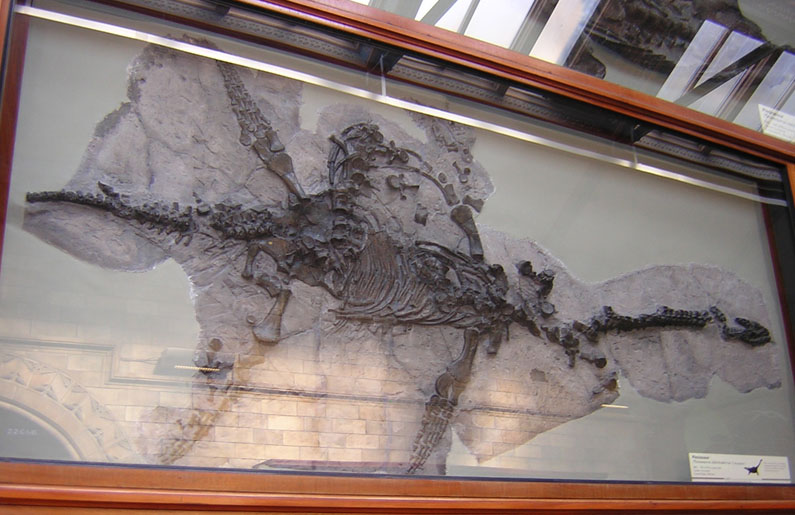Plesiosaurus

Sauropterygia
Eosauropterygia
Eusauropterygia
Pistosauroidea
Pistosauria
Plesiosauria
Plesiosauroidea
Plesiosauridae
P. dolichodeirus
Plesiosaurus was the first plesiosaur discovered and named (De la Beche and Conybeare 1821). The first 1821 description was based on partial remains so the anatomy of Plesiosaurus – particularly the identity of the isolated bones and how they articulated together – involved some guesswork.

The type species (P. dolichodeirus) was named a few years later (Conybeare 1824) following the discovery of a complete articulated specimen (NHMUK 22656) by Mary Anning in Lyme Regis. This skeleton provided clarity on the anatomy of Plesiosaurus, and showed that the animal had a long neck.

For a long time Plesiosaurus was treated as waste-basket taxon and many different specimens were allocated to the genus Plesiosaurus under different species names, even when they were very different. By modern standards, most of these specimens deserve a generic name of their own or may be of dubious validity. The lumping of many species into the genus Plesiosaurus was initiated during the 1800s when plesiosaurs were first being studied and described. Many species formerly included in Plesiosaurus are now renamed and most of them do not even belong in the family Plesiosauridae. For example, ‘Plesiosaurus’ rostratus was renamed Archaeonectrus, and ‘Plesiosaurus’ conybeari was renamed Attenborosaurus.

Storrs (1997) reduced the number of valid species of Plesiosaurus to three. However, two of those have unique features that warrant generic separation: ‘Plesiosaurus’ guilielmiiperatoris is today regarded as Seeleyosaurus, a name reinstated by Grossman (2007), and ‘Plesiosaurus’ brachypterygius is now known by the name of Hydrorion (Grossman 2007). All this means that at present, Plesiosaurus contains only the single valid species, P. dolichodeirus. Some species arbitrarily referred to Plesiosaurus still remain today, pending revision. ‘Plesiosaurus’ macrocephalus, for example, is possibly a juvenile rhomaleosaurid.
Plesiosaurus belongs to the family Plesiosauridae and was regarded as the sole member of the group for several years. However, recent research into early Jurassic plesiosaurs has revealed a greater generic diversity of plesiosaurids.
Plesiosaurus dolichodeirus
The holotype specimen of P. dolichodeirus (Conybeare 1824) is NHMUK 22656, a complete skeleton, discovered and collected by Mary Anning.







‘Plesiosaurus’ macrocephalus
This iconic plesiosaur skeleton (NHMUK PV R 1336) was discovered by Mary Anning in Lyme Regis in December 1830. Regarded as her last major discovery, it was first figured under the name “Plesiosaurus macrocephalus” by William Buckland in 1836, and later described by Richard Owen in 1840 (Owen 1840). The fossil was originally purchased by Lord Cole in 1831. It was subsequently acquired from him by the Natural History Museum, London, where it has remained on display in the museum’s ‘Fossil Marine Reptiles’ hall.
The skeleton has a proportionally large head and small flippers, poorly ossified limb bones and vertebrae, and a small overall body size. These characters suggest the individual was immature. ‘Plesiosaurus’macrocephalus certainly does not belong to the long-necked, small-skulled genus Plesiosaurus. It is probably a juvenile rhomaleosaurid but has not yet been assigned to a new or existing genus. So, pending revision of the taxon and referral to a different or other existing genus, it is still named ‘Plesiosaurus‘, following Owen.


